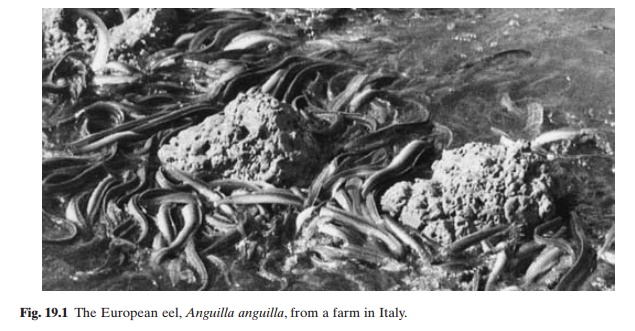Chapter: Aquaculture Principles and Practices: Eels
Collection and rearing of seed eels
Collection and rearing of seed
eels
As
indicated earlier, eel culture is based on seed eel collected from the wild.
Several attempts have been made to propagate A. anguilla and A. japonica artificially,
starting as early asthe 1930s (Boucher et
al., 1934). Spontaneous release of eggs was obtained by Fontaine et al. (1964) in the European eel.
Boëtius and
Boëtius (1967) were able to mature males of the species by weekly injections
with carp pituitary and maintaining them in sea water at a temperature of about
14°C. Several other workers have subsequently succeeded in
maturing
the males, as well as obtaining the release of mature eggs from females, but
artificial fertilization of the European eel has not been a success. The
Japanese eels have been stimulated to spawn by hormone injections and by
keeping the brood fish in sea water at a temperature of about 23°C (Yamamoto et al., 1975), but the larvae could be
reared only until the sixth day.
In
Europe, the collection of elvers is done either during winter and spring or in
the beginning of summer in June and July, when they ascend the rivers. They
seem to be able to migrate up the rivers at lower temperatures of 2–10°C, unlike
the Japanese eels. The early migrants are smaller in size (about 7 cm in
length), but the later ones are larger (15–20 cm in length). These are probably
the elvers that hatched out the previous year and they ascend further up the
river than the smaller ones. The elvers for restocking or rearing are collected
during the earlier migration which starts around December. The best catches are
generally obtained from February to May. They are captured with large
wire-meshed sieves or large nets similar to a plankton net dragged from a
powered boat.The catches are stored in aerated tanks for transport ashore.
In Japan,
the elvers enter the rivers from October through to late May, when the water
temperature reaches 8–10°C.They are caught in scoop nets at night, using bright
lights as attractants, or by using fine-meshed bag nets set across the river.
Special elver traps may also be set near obstructions across the rivers, where
the elvers are likely to congregate. In Taiwan, the elvercatching season is
from October to March. They are caught with scoop nets, drag nets or eel traps.
Elvers
need careful handing after capture and during rearing. It is a common practice
to condition them for a day after capture, in special bamboo baskets or tanks.
They can be transported to distant farms, packed in wooden boxes.
Intercontinental shipments of elvers have also been made in polythene bags,
after conditioning at low temperatures of 4–7°C.
Before
release of elvers into nursery ponds, many farmers give them a bath of malachite
green to prevent infection. To protect the elvers from cold winds, the ponds
may be covered with vinyl sheets. Some farmers use electric
heaters
to maintain the water temperature at about 10°C. A common system of rearing
elvers in Japan is to stock them initially at higher densities in a series of
ponds, and when they grow larger to transfer them to a series of progressively
larger ponds at lower densities. The first series is about 165 m2 in
size, with a depth of about 40 cm, and the stocking rate is about 500–600 g
elvers per m2. The larger ponds are about 200 m2 in area.
Most eel ponds have vertical concrete or brick walls and sandy soil bottoms,
although there are some with steep mud walls and mud bottoms. The seed eels can
climb considerable distances up the wall, especially during heavy rains, and so
it is desirable to have some protective devices at the top of the walls to
prevent their escape.
Before the elvers are released, the nursery ponds are disinfected with lime. As mentioned earlier, the stocking density in Japan is 500– 600 g per m2, but in Taiwan it may be almost 10 times that. European elvers are stocked at the rate of 3500–10 000 g per ha. Feeding is started when the water temperature is about 15°C. As they are nocturnal in feeding habits, the feeding spot is covered with boards or other suitable material, to make it as dark as possible. Small worms are considered a suitable first feed for elvers, and after two or three days fish flesh is added in progressively increasing quantities until about the tenth day, when a paste of minced fish is given. Formulated eel diets are now in use in many farms. The recommended protein level in practical diets for elvers is 50–60 per cent and for subadults, 40–45 per cent. Even though the amount of feed consumed by elvers depends on the condition of the water and the temperature, the recommended normal daily ration is about 30 per cent of the total weight of the released elvers, fed in several lots. Adequate feeding is important to reduce cannibalism. When the elvers overgrow the capacity of the pond (indicated when they congregate near the surface and breathe atmospheric air), the stock is thinned out. Eels can be scooped out easily from near the feeding place and transferred to larger ponds. The stocking rate then is about 150–200 g per m2. In about four months the elvers grow to around 7 g, and in another four months they reach about 100 times their size at stocking. It is essential to ensure that no filamentous algae develop in the ponds, as elvers are likely to hide under them and refrain from feeding. Usually elver farmers start catching and selling some of the stock as they grow in size, according to market demand.

Related Topics